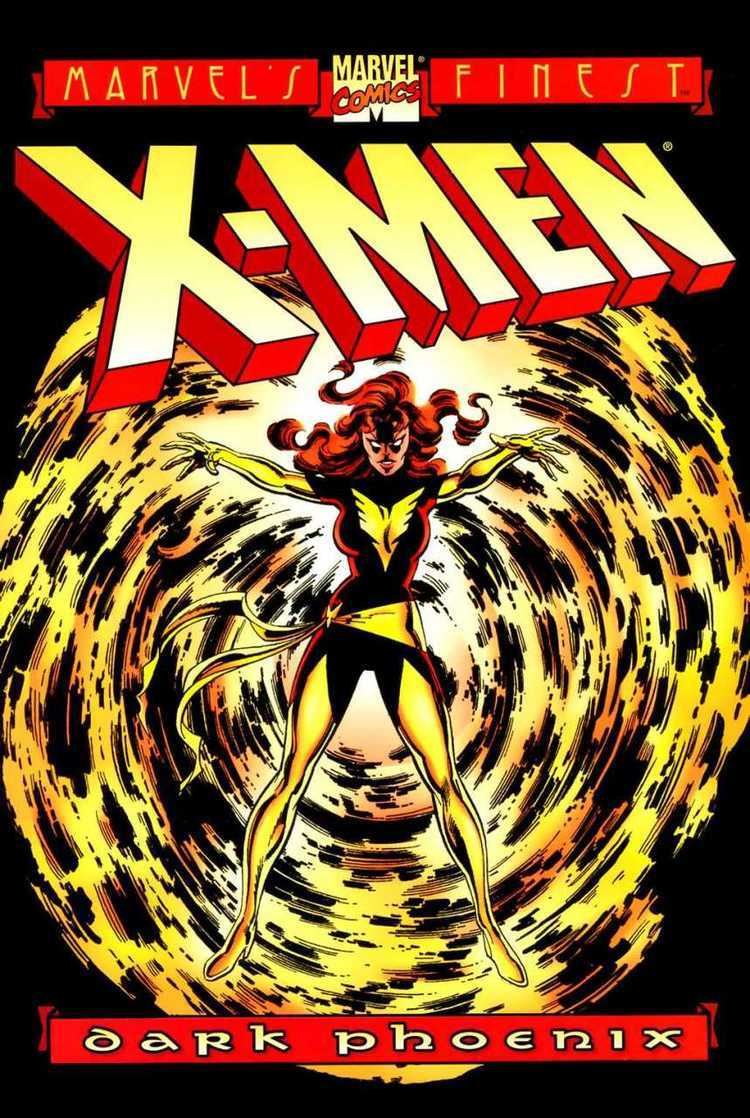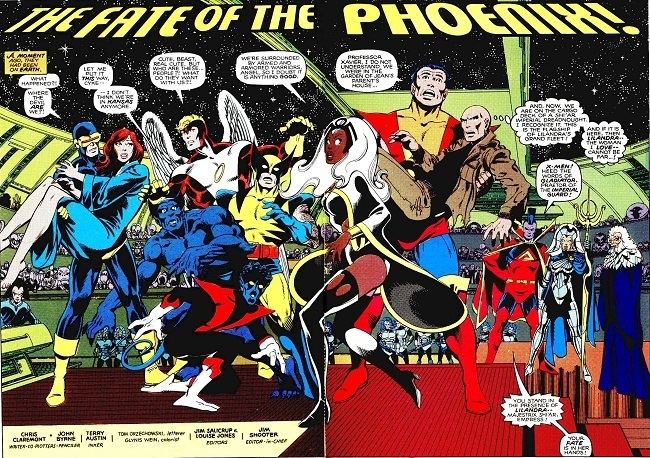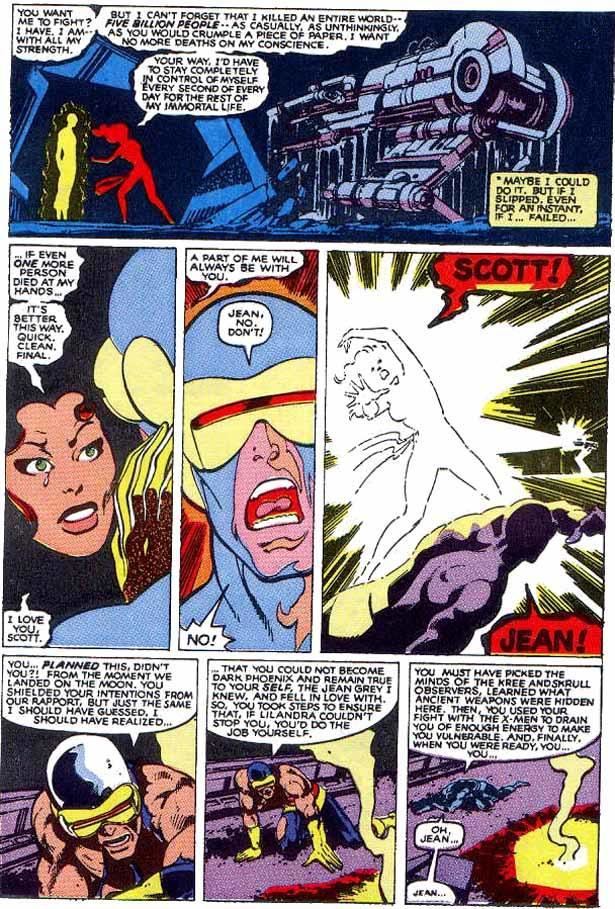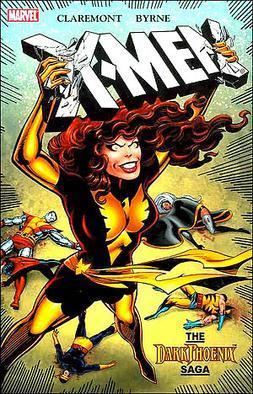Publication date January – October 1980 | ||
 | ||
Main character(s) X-MenHellfire ClubLilandraShi'ar Imperial GuardPhoenix Force Writer(s) Chris ClaremontJohn Byrne | ||
Epic history x men volume 3 the dark phoenix saga
"The Dark Phoenix Saga" is an extended X-Men storyline in the fictional Marvel Comics Universe, focusing on Jean Grey and the Phoenix Force. It was written by Chris Claremont with art by Dave Cockrum and John Byrne.
Contents
- Epic history x men volume 3 the dark phoenix saga
- Marvel history x men the dark phoenix saga
- Plot summary
- Background and creation
- Jean Grey and Phoenix as separate entities
- Sequel
- Television
- Film
- Parodies and imitations
- Collected editions
- References

It is sometimes divided into two parts, with the "Phoenix Saga" (Uncanny X-Men #101-108, 1976–1977) referring to Grey's seeming assumption of the Phoenix power and the repair of the M'Kraan Crystal, and the "Dark Phoenix Saga" (Uncanny X-Men #129-138, 1980) referring to her corruption and fall. It is one of the most well-known and heavily referenced stories in mainstream American superhero comics, and widely considered a classic.

It was adapted for the X-Men animated series, and alluded to in the movie X2: X-Men United. A third movie, X-Men: The Last Stand, released in 2006, contains some elements from the saga. Wolverine and the X-Men adapted the "Dark Phoenix Saga" at the end of its first season, though it changed many elements of the story.

Marvel history x men the dark phoenix saga
Plot summary

Returning from a mission in space, Jean Grey is exposed to the deadly radiation of a solar flare, and briefly attains her ultimate potential as a telepath and telekinetic. Jean becomes a being of pure thought, and then reforms herself upon return to Earth with the new costume, identity and power of "Phoenix". It is with this incredible power that Jean repairs the fractured M'Kraan Crystal, but voluntarily restrains her powers afterward in order to keep them under control. Tragically the circuit breakers prevent her from defeating Magneto and start the chain of events leading to Dark Phoenix.

Her vast potential makes her a target for Mastermind, who is attempting to prove himself in order to join the prestigious Inner Circle of the Hellfire Club. Under the identity of Jason Wyngarde, he begins to seduce Jean. With the help of a mind-tap device created by the Club's White Queen, Emma Frost, Mastermind projects his illusions directly into Phoenix' mind. These illusions cause her to believe that she is reliving the memories of an ancestor, Lady Grey, who in Mastermind's illusions was the Hellfire Club's Black Queen and the lover of one of Wyngarde's ancestors. Phoenix eventually accepts the Black Queen as her actual identity, a decadent role that allows her to relish the extremes of human emotion and begins to break down the barriers that she had erected.

She helps the Hellfire Club capture the X-Men, and Jean's true love Cyclops faces Mastermind in a psychic duel. When Mastermind kills Cyclops' psychic image, it breaks his hold over Jean's psyche and shatters the final barriers on her power. Experiencing this power in its totality overwhelms Jean, and she renames herself "Dark Phoenix". Enraged at Mastermind, she uses a telepathic illusion to make him experience godhood, driving him insane. To break her ties with her less powerful identity as Jean Grey she strikes down the X-Men and departs for a distant galaxy, as her ascension is detected by psychically, magically, and cosmically sensitive superheroes across Earth and the rest of Marvel Universe such as Spider-Man, Doctor Strange, the Silver Surfer, and the scientific instruments of Mister Fantastic. However, her power proves to be far more limited than she thought; the intergalactic trip leaves her almost completely drained. To recharge, she devours the energy of the nearby D'Bari star, causing a supernova which kills the entire population of the only civilized planet orbiting the star. A Shi'ar vessel attacks to prevent her from destroying other stars. Dark Phoenix easily destroys the vessel, but not before they alert the Shi'ar Empress Lilandra. A council of intergalactic associates is gathered, including the Kree and Skrull empires, and concludes that Dark Phoenix is an even more serious threat than the planet-consuming Galactus and must be destroyed.
On Earth, the X-Men are greeted by Avengers member (and former X-Man) Beast. Dark Phoenix returns to Earth, to her family's home, and finds herself conflicted between her normal feelings for her loved ones and her new destructive impulses as Dark Phoenix. The X-Men attack her but are again defeated. Her mentor, Charles Xavier, arrives, and through a vicious psychic duel, he creates a new set of psychic "circuit-breakers" which reduce her to only her original Marvel Girl powers. This allows Jean's normal personality to reassert control.
The Shi'ar abduct the X-Men, tell them of Dark Phoenix' casual genocide, and declare that she must be put to death. Xavier challenges Lilandra to Arin'n Haelar, a Shi'ar duel of honor that cannot be refused. After conferring with the Kree and Skrulls, who privately demand a guaranteed victory for their side in order to proceed with Phoenix's death sentence, Lilandra agrees to Xavier's demand.
The next day, the X-Men and the Shi'ar Imperial Guard are teleported to the Blue Area of the Moon to do battle, with the victors deciding the fate of Phoenix. The Imperial Guard defeat most of the X-Men, leaving Cyclops and Phoenix alone to make a final stand. When Cyclops is seemingly killed, Jean's panic overrides Xavier's psychic restraints and restores her to Dark Phoenix. Lilandra initiates Plan Omega, which would consist of destroying the whole solar system in hopes of eliminating Dark Phoenix in the process. With events going too far, Xavier orders the X-Men to subdue Jean to preempt Lilandra's emergency measure. They battle her until she regains her senses. Running inside one of the Blue Area's ruins, Jean, struggling to keep control, activates an ancient Kree weapon which disintegrates her after an emotional good-bye to Cyclops. He deduces that Jean had planned her sacrifice from the moment they had landed on the moon.
The story ends with Uatu the Watcher commenting to an attending Recorder that "Jean Grey could have lived to become a god. But it was more important to her that she die...a human."
Background and creation
The segment of the saga set at the Hellfire Club (Uncanny X-Men #132–134) was heavily inspired by the Avengers episode "A Touch of Brimstone", and some of the characters' appearances were modeled after the cast of "A Touch of Brimstone" as a subtle acknowledgment of the inspiration.
The ending of the story was a matter of intense controversy with the editorial staff. Jim Shooter's recollections are that the original intent of the Dark Phoenix storyline was to introduce Dark Phoenix as a cosmic nemesis for the X-Men. This was what had been discussed originally amongst the creative team and Shooter, and this was the story development that had been approved. When Uncanny X-Men issue 135 was in the final artwork stages, Shooter happened to look at the proofs for the issue and noticed that the story included the destruction of an inhabited solar system, with an explicit mention of billions of lives lost. Louise Simonson feels it was Shooter's outrage over this plot element which led to him taking editor Jim Salicrup off the series several issues earlier than he had been scheduled to.
Upon questioning Salicrup about where the plot went from there, he was told that issue 137 ended with Jean being permanently depowered by the Shi'ar and released into the custody of the X-Men. Shooter disagreed with this development both from a storytelling standpoint as well as, secondarily, a moral standpoint, likening the ending to "taking the German army away from Hitler and letting him go back to governing Germany," and finding it out of character for the X-Men to retain friendly relations with a being who had committed genocide. Byrne and Salicrup explained that they had no problem with this resolution because they had always thought of Dark Phoenix as a separate entity who had possessed Jean Grey, with Salicrup drawing an analogy to the film adaptation of The Exorcist: "In the movie there's this little girl who's taken over and several people get killed, but by the end, when the demon's gone no one thinks, 'Let's kill that murderous little girl.'" However, on reading the issues over they agreed with Shooter that from the reader's perspective, she did not seem to be possessed, and Claremont admitted that while writing the Dark Phoenix Saga he was never clear in his own mind whether Jean Grey was possessed or her actions as Dark Phoenix were her own.
Shooter, during a conversation with Claremont, suggested a scenario where Jean would be permanently imprisoned as a compromise, and Claremont responded that such a scenario was unfeasible since in his opinion, the X-Men would want to continually try to rescue Jean from imprisonment. According to Shooter, Claremont out of frustration suggested that they kill off Jean completely. Although Shooter suggests that the proposed plot point was a bluff by Claremont, playing on the unwritten rule that main characters were not to be killed permanently, he accepted it, even over later objections by both Claremont and Byrne. Ultimately, it was decided by Byrne and Claremont to have Jean commit suicide after her Dark Phoenix persona resurfaces at the climax of the fight against the Imperial Guard. Issue 137 was left largely unchanged, but the last five pages were completely rewritten and redrawn for the new ending, and Claremont also took the opportunity to write a second draft of his script. Because of this, comparison of the original and published versions of X-Men #137 reveals numerous differences in the script with no connection to the ending; for instance, in the original version of the day of rest, the individual X-Men are each thinking of their own personal issues, while the published version shows them reflecting on their decision to protect Jean.
The original ending ultimately saw print in 1984 in Phoenix: The Untold Story. Besides the original version of Uncanny X-Men #137, it featured a transcript of a round table discussion between Claremont, Byrne, Simonson, Salicrup, Shooter, and inker Terry Austin, discussing the story behind the original ending and why it was changed.
Jean Grey and Phoenix as separate entities
Shortly before the publication of Uncanny X-Men #137, future freelance writer Kurt Busiek, then still a college student, heard about the upcoming events through the fan grapevine, as did fellow future comics pros Carol Kalish (who would go on to head up Marvel's Direct Sales Department for years) and Richard Howell (artist of the Vision and The Scarlet Witch 12-issue limited series, among others). The three of them also heard that Marvel editor-in-chief Jim Shooter had declared that Jean Grey could not be revived unless it was done in such a way as to render her guiltless of Dark Phoenix' crimes. Taking this as a creative challenge, all three then-fans decided to come up with their own resurrection scenario. Busiek's involved the discovery that Jean Grey was still on the bottom of Jamaica Bay in suspended animation following the original shuttle crash and that the Phoenix entity had used her body and mind as a lens, creating an immensely powerful duplicate of Jean, but one which grew more corrupted and distorted the longer it remained separate from the true Jean.
In 1982, Dark Phoenix resurfaced in the DC/Marvel intercompany crossover one-shot The Uncanny X-Men and The New Teen Titans, written by regular X-Men writer Chris Claremont. The story (which is not part of DC or Marvel canon) has the cosmic villain Darkseid resurrect Jean Grey in her Dark Phoenix persona as part of his quest to discover the secret of the Anti-Life Equation. In the end, Dark Phoenix is betrayed by Darkseid and sacrifices her life yet again to stop Darkseid.
Also in 1983, shortly after beginning a freelance writing career, Kurt Busiek attended a comics convention in Ithaca, New York, staying at the home of Marvel writer Roger Stern. In conversation, both writers' longtime interest in the X-Men came up, and Stern expressed regret that there was no way to bring Jean back, not while satisfying Shooter's edict. Busiek told Stern his idea, not expecting it to amount to more than idle conversation. Later, Stern told the idea to John Byrne, then writer/artist of Fantastic Four.
In 1985, Jim Shooter greenlit a new series that would reunite the original X-Men into a new team called X-Factor, to be written by longtime freelancer Bob Layton. Hearing of this, Byrne called Layton and suggested Busiek's idea as a means of raising Jean Grey from the dead while satisfying Shooter's demands for total absolution for Jean.
A three-part crossover was planned to launch X-Factor, involving the Avengers, the Fantastic Four, and the debut issue of X-Factor, thus involving Avengers writer Stern, Fantastic Four writer/artist Byrne and X-Factor writer Layton. Busiek, by that time, was working at Marvel as a freelance assistant editor on Marvel Age Magazine. He was paid and credited for the idea, and edited a series of interviews for Marvel Age promoting the new series. Ironically, everything in the interviews pertaining to Jean's resurrection was marked out with black tape to create an air of mystery about the revelations that the crossover would involve, and Busiek thus found himself taping over the names of the writers giving him credit for the idea.
Sequel
Uncanny X-Men #168 (April 1983) began a subplot which culminated with the apparent reincarnation of Dark Phoenix in Uncanny X-Men #174-175 (October–November 1983). These issues were later collected in trade paperback form under the title "From the Ashes".
The story revolves around Cyclops and the newly introduced Madelyne Pryor, a commercial airline pilot who is not only physically identical to Jean Grey, but survived a traumatic airliner crash at exactly the same moment that she died. Pryor's transformation into Dark Phoenix is revealed to be an illusion by Mastermind, seeking revenge for what Jean Grey did to him during "The Dark Phoenix Saga". In issue #175, Cyclops and Madelyne repeat the dialogue he exchanged with Jean Grey after Professor X locked away her Dark Phoenix powers, marking the parallel with the dissolving of Mastermind's Dark Phoenix illusion.
Television
Film
Parodies and imitations
Southern Knights #30 (December 1988) opens with a four-page parody of "The Dark Phoenix Saga", with the character Connie Ronnin wreaking havoc as "Dark Connie".
Redfox #5-10 (September 1986 - July 1987) are officially titled "The Demon Queen Saga", and the plot is essentially "The Dark Phoenix Saga" translated to a sword-and-sorcery setting.
Army Surpluz Comics #5 had Cutey Bunny transformed into Dark Cutey due to her magic amulet interacting with Wunner Bunny's magic lasso and other forces. Once transformed she tempts her former friends with the merchandising potential of being "dark" and finally engages in a pie fight with some incompetent super-heroes from WWII. She is still Dark Cutey at the end.
Power Pachyderms (one-shot) had 4 anthro elephants (born to circus elephants irradiated by the gamma bomb that first turned Bruce Banner into the Hulk.). They are takes on Cyclops (Trunklops), Wolverine (Rumbo, and Colossus, whereas Electralux parodied Electra. In a battle with Clarinetto and his New Musicians, she is buried in radioactive make-up and becomes Rogue Elephant whose song can destroy anything. They had to blow the make-up off her to return her to herself.
Collected editions
The story (issues #129-137) was first collected as a trade paperback in 1984. The first edition featured a cover painting by Bill Sienkiewicz.
To celebrate the 30th anniversary of the Phoenix Saga, it was announced that this storyline would be reprinted in an oversized trim hardcover. The X-Men: The Dark Phoenix Saga hardcover (352 pages, July 2010, Marvel, ISBN 978-0-7851-4913-2) collects The X-Men #129-138, Classic X-Men #43, Bizarre Adventures #27, Phoenix: The Untold Story (one-shot), and What If? #27.
The story (The X-Men #129-137) has been collected into a number of trade paperbacks:
The story is also included in Essential X-Men, Volume 2 (584 pages, October 1997, Panini Comics, ISBN 978-0-7851-0298-4), part of Marvel's Essential series of black-and-white trade paperbacks. The volume collects The X-Men #120-144 and The X-Men Annual #3-4.
The story is included in the hardcover Marvel Masterworks: Uncanny X-Men, Volume 4 (The X-Men #122-131, Annual #3) and Volume 5 (The X-Men #132-140, Annual #4), and the opening of the story is in the final pages of Uncanny X-Men Omnibus, Volume 1, which includes Giant-Size Uncanny X-Men #1, The X-Men Annual #3, and The X-Men #94-131.
Finally, the saga was printed in hardback form for issue 2 of The Official Marvel Graphic Novel Collection, a graphic novel series based in the United Kingdom, Ireland, Australia, New Zealand and South Africa, in January 2012.
